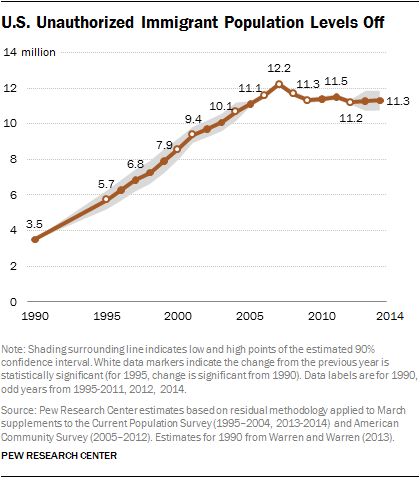
Pew Research Center (PEW) is the gold standard for estimates on the number of undocumented aliens living in the United States. According to PEW, the overall number of undocumented aliens has held steady since 2009. But are the PEW numbers really reliable? What methodology does PEW use to calculate them? Fortunately, PEW explains its methodology on its website. Its estimates are based on a residual estimation methodology that compares a demographic estimate of the number of immigrants lawfully residing in the country with the total number of immigrants as measured by a survey. The difference is assumed to be the number of unauthorized immigrants. This is easier to understand in the form of an equation.
Unauthorized Immigrants (U) = Survey, Total Foreign Born (F) - Estimated Lawful Immigrant Population.
The lawful resident immigrant population is estimated by applying the demographic methods to counts of lawful admissions which are obtained from the Department of Homeland Security (DHS) Office of Immigration Statistics, with projections to current years, when necessary. Some of the statistics on lawful residents should be very reliable. DHS grants Lawful Permanent Resident status and other forms of lawful status and keeps records of the grants. But it has been estimated that 40% of the undocumented alien population entered as nonimmigrant visitors of various types. This includes aliens who entered as nonimmigrant visitors for pleasure and did not leave when their admission periods expired and other categories of nonimmigrants who violated the terms of their admissions. DHS does not know at any given time how many of the nonimmigrants are still in lawful status.
The foreign born population includes anyone who is not a U.S. citizen at birth, including those who become U.S. citizens through naturalization. PEW estimates of the total foreign born population are based primarily on government census surveys. It currently relies on the U.S. Census Bureau’s American Community Survey. This survey includes questions on race, place of birth, citizenship, and when a person came to live in the United States. It is a nationwide survey designed to provide communities with reliable and timely demographic, housing, social, and economic data every year. About 3.5 million housing unit addresses are selected annually. That may sound like a large number, but it is less that 2% of the more than 180 million addresses in the United States. And the United States population in 2015 was estimated to be 321,418,820 people. These addresses cover every county in the nation. The forms are mailed to the selected addresses, not to individuals. For 2015, the American Community Survey selected 3,540,307 addresses in its survey of housing units and had 2,305,707 final interviews. The American Community Survey also selected 206,630 group quarters facilities, such as college dormitories, nursing homes, and prisons; and had 161,865 final interviews at these locations.
PEW also has relied on statistics from the March Supplement to the Current Population Survey. But PEW has dropped that survey because the American Community Survey provides a much larger sample size. In 2014, it produced statistics on 360,000 foreign born individuals, and the March Supplement only provided statistics on 26,000 foreign born individuals. PEW has replaced its March Supplement estimates from 2005 onward with American Community Survey-based estimates.
I have several concerns about PEW’s reliance on the American Community Survey. First, I would be very surprised if many households with an undocumented alien are willing to participate in a government survey of any kind; and this one includes questions about race, place of birth, citizenship, and when a person came to live in the United States. An undocumented alien would not have to be paranoid to be suspicious about why those questions are being asked. I encourage you to read a sample of the form and judge for yourself. Second, I do not understand how PEW can make a reliable estimate of the total foreign born population on the basis of a survey that is sent to such a small portion of our population, particularly in view of the fact that the surveys are spread out across every county in the United States, which makes it unlikely that a reliably representative sampling is taken anywhere. Also, roughly 35% of the 3,540,307 mailings did not result in a final interview. The surveys at group facilities are even less impressive. Who are these people who would not participate in the survey? How different would the results have been if they had participated?
The problem is not that PEW is using questionable statistics for estimating the lawful immigrant population or that its source of statistics for estimating the foreign born population is unreliable. Math was one of my majors in college. Philosophy was the other. I know that estimates based on such statistics typically are not very reliable. The problem is that PEW’s estimates on the number of undocumented aliens in the United States are being used to make important policy decisions. For instance, the illegal immigration situation is much different if PEW is right that the population of undocumented aliens has remained steady since 2009, than it would be if the population actually has increased from five million to 33 million. Another example is legalization. Estimates for the resources and funding needed for a legalization program are based on PEW’s estimate of how many undocumented aliens there are. The bottom line is that we need to find a more reliable way to estimate the population of undocumented aliens.
